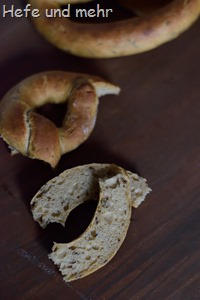 When I was researching another recipe, I stumbled upon the recipe for anise pretzels . These pretzles are made without lye and are typically served during winter in the region Upper Franconia. They contain a lot of anise, as their name promise.
When I was researching another recipe, I stumbled upon the recipe for anise pretzels . These pretzles are made without lye and are typically served during winter in the region Upper Franconia. They contain a lot of anise, as their name promise.
Interestingly it seems that the recipe vary from town to town: In Weidenberg the dough is made without the addition of fat, while in a recipe from Bayreuth the dough is enriched with some milk and butter. I liked the richer variant more and so my dough contains both milk and butter, too. A egg yolk is added as emulsifier and helps to create fluffy and soft crumb.
Anisbrezen
yields 10 pretzel
Rye -Poolish 
- 80g rye flour Type 1150
- 160g Water
- 0,3g fresh yeast
Dough
- 420 g Flour Type 550
- 100g Water
- 40g Milk
- 20g egg yolk (of one egg size L)
- 30g Butter
- 20g inactive Malt
- 12g Salt
- 10g Yeast
- 20g Anise
Mix water, flour and yeast for the poolish and ferment it overnight (12 to 16 hours).
The next morning: Mix all ingredients for the dough and knead it for about 5 min at low speed, then 10 min on high speed.
Ferment the dough for one hour.
Divide the dough into pieces of 80g and form them to light balls. Rest them for 20 min.
Now roll the dough to a strand of 70 cm. The strand should be a bit thicker in the middle then at the ends. Form to a pretzel and place on a baking tray lined with baking parchment.
Proof one hour on room temperatur.
Bake it at 250°C for 15 min.
Deutsch



Bin selbst Franke und muss sagen, das Rezept ist herrlich. Der Mehraufwand durch den Vorteig lohnt sich. Die Brezen schmecken wie zu Hause. Danke für das Rezept.
Hallo Stefanie,
diese Brezen habe ich Jahrzehnte lang vermisst, und jetzt nach deinem Rezept gebacken: Sagenhaft! Wie in alten Zeiten! Es hat auf Anhieb geklappt und kommt auch bei Anderen gut an, die eigentlich nur Salz- und Laugenbrezeln kennen. Für mich eine echte Bereicherung, ich freue mich sehr und werde sie in Zukunft oft backen. Vielen Dank!
@Sabine: Das freut mich sehr 😀
Ich habe das Rezept nun schon zweimal gemacht. Das zweite Mal gleich doppelte Menge,dann mit noch etwas gemahlenen Anis zusätzlich.
Außerdem hab ich aus dem Teig auch Brötchen gemacht,sie werden super-innen schön fluffig u ausgefüllt,außen herrliche Kruste. Sowohl Brezen als auch Brötchen lassen sich sehr gut einfrieren und nach dem Auftauen auf den Toaster gelegt schmecken sie wie frisch aus dem Backofen.
Aber das Allerbeste ist,dass sie wirklich genauso gut schmecken wie die Originale-hatte den direkten Vergleich mit den “Bayreuthern”. 1000 Dank für diese tolle Rezept,so kann ich mir meine Kindheitserinnerung nun endlich selbst backen.
@Angie: Das freut mich sehr 😀
Hi Stephanie!
muss man das Roggenpoolish überdeckt gehen lassen?
Und muss man das Poolish dann ganz normal zu dem anderen Teig später hineinmischen oder?
Vielen Dank Dir schon einmal für eine Antwort 🙂
@Philipp: Der Poolish wird abgedeckt und kommt dann später mit in den Teig, da hast du ganz recht 🙂
Hallo Stefanie,
ich bin noch am Üben: den Anis ganz oder gemahlen?
@Barbara: Die Anis-Samen bleiben ganz.
Hallo Stefanie,
meinst du wirklich 0,3 g Hefe, oder sollen das 3 g sein??
@Erika: Ich meine wirklich 0,3g, sonst geht der Vorteig zu schnell. Wenn du das nicht abwiegen kannst, nimm ein Mini-Bröselchen Hefe (etwa 1/3 Reiskorn groß).
Haha, vielen Dank!